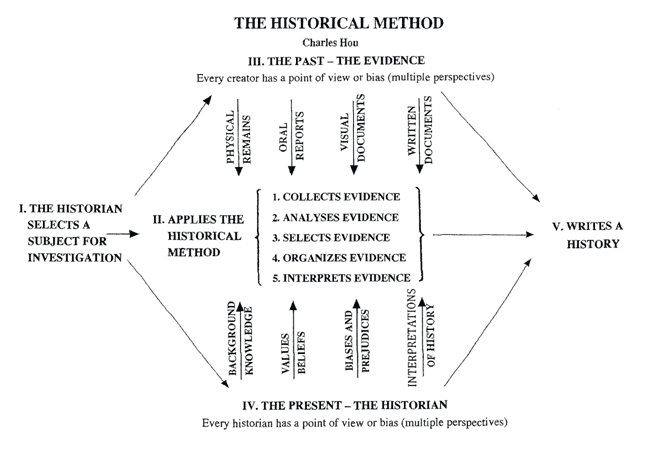|
1. Collects Evidence
The historian gathers all possible remains or records containing information on an historical event, relying heavily on primary and secondary sources. A primary source is the evidence of an eyewitness – one who was present at the events described – or other remains from the past. A secondary source is the evidence of anyone who was not an eyewitness, and is usually written after the fact with the benefit of hindsight. These sources become evidence once the historian selects them to answer the question under investigation.
2. Analyses Evidence
The historian asks questions about primary and secondary sources in order to turn the information they contain into valuable evidence. In trying to determine the accuracy and reliability of a source, the historian must keep in mind the point of view of the witness or the creator of the source. Historians make inferences about how people thought and felt about the past based on the sources and the context in which they were created. A source cannot be properly evaluated until we know the what kind of source it is, when it was produced, where it was produced, who produced it and why it was produced.
3. Selects Evidence
There is usually much more information available than one can use. The historian decides what evidence is significant and relevant to the study and rejects the rest.
4. Organizes Evidence
The historian arranges evidence in a meaningful way, looking for facts to help answer the question posed at the beginning of the inquiry.
5. Interprets Evidence
The historian uses the facts and information in the available documents to make inferences and to develop an interpretation which is logical and consistent with all the available evidence. A good thesis should be based on a number of documents containing a variety of perspectives, and should include references to the sources to provide support for the conclusions drawn.
III. The Past – The Evidence
The unique events of the past are unrepeatable, and accessible to the historian only through surviving historical sources (physical remains, verbal reports, pictorial records or written documents – the raw materials of history). History comes from the evidence supplied by the critical analysis and evaluation of these documents.
A scientist
witnesses the actual event
can repeat an experiment
tries to be as objective as possible
An historian
sees not the event, but the remains of the event
cannot recreate the event
draws subjective conclusions
1. Physical Remains
roads, temples, furniture, pottery, weapons, food, utensils, battle sites, fortifications, churches, roads, bridges, aqueducts, monuments
2. Verbal Reports
legends, ballads, interviews, speeches, recordings
3. Visual Documents
paintings, photographs, films, videos, maps, cartoons, posters, sculptures
4. Written Documents
diaries, memoirs, autobiographies, letters, diplomatic dispatches, pamphlets, newspapers, government reports, census records.
IV. The Present – The Historian
The historian always views and interprets the past from the standpoint of the present. Just as the point of view of the creator of a primary or secondary source influences that individual’s record of an event, the historian’s personality shapes his or her selection of topics, analysis and evaluation of evidence, and the selection, organization and interpretation of the evidence. Historians should be aware of how the following factors influence the way they make sense of the past.
1. Background Knowledge
Reading, education and historical context influence an historian’s judgment about the past.
2. Life experiences (biases)
Life experiences influence the historian’s world view or point of view Major factors include place of birth and upbringing, religion, race or ethnic origin, gender, economic position, marital status, education, family and friends and vocation. Good historians do not let these biases prevent them from looking at the facts before making inferences or forming an opinion about events.
3. Personal Values and Beliefs
Personal values (ethics) or beliefs may predispose the historian to interpret history in a certain way. For example, views on individuality or conformity; spiritualism or materialism; cooperation or competition; liberalism or conservativism; nature or science; assimilation or diversity; melting pot or mosaic.
4. Interpretations
Historians do their best to make sense of the past. Sometimes they see major patterns in history that repeat over and over again. Those who see the same patterns form themselves into schools of interpretation (philosophy of history). Some of the major interpretations applied to Canadian history are good versus evil, progress and decline, the rise and fall of civilizations, the struggle for survival, the empire of the St. Lawrence, the biographical approach and metropolitanism. Some historians focus on a particular aspect of the past that interests them (economic, cultural, military, political and intellectual historians). An historian’s interpretation will have an impact on his or her explanation of the past.
V. The Historian Writes a History
The historian uses the evidence collected to provide an answer to the question under consideration. The value of the interpretation depends on the quality and quantity of the evidence and the historian’s analytical skill and writing ability. Multiple interpretations result from the interplay of the evidence from the past and the historian.
VI. The Historical Method and the Big Six
1. Historical Significance
The Historian Selects a Subject for Investigation
2. Evidence
The Historian Collects and Analyses Evidence
3. Continuity and Change
The Historian Organizes and Selects Evidence
4. Cause and Consequence
The Historian Organizes and Selects Evidence
5. Historical Perspectives
The Historian Interprets Evidence
6. The Ethical Dimension
The Historian Interprets Evidence
All of these stages are influenced by the perspectives of the person who left traces of the past (evidence) and the historian
|
